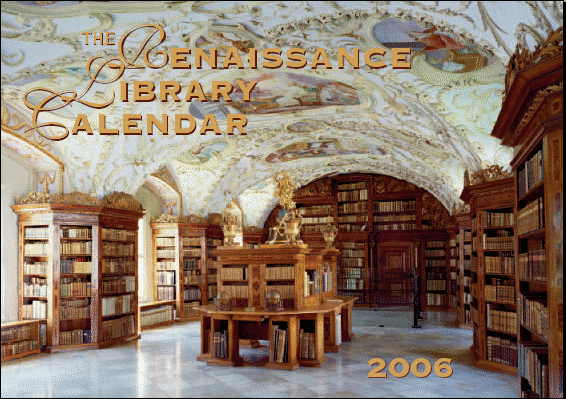
ASSOCIATES (2005, November, v. 12, no. 2) - associates.ucr.edu
*The Renaissance Library Calendar 2006*
Product review
by
Jean Turner Weiss
Science Library
University of California, Riverside
jweiss@ucr.edu

Twelve beautiful photographs of library interiors invite one into the past to experience their architecture and history. Although most are characterized by massive walls of bookcases, functional reading tables and soft comfortable chairs, each has a unique origin and style. This year librarians and information professionals from over 40 countries have nominated their favorite libraries, with the winners appearing in this sixth (2006) edition.
The earliest collection in “The Renaissance Library Calendar” goes back to 597 A.D. when St. Augustine brought books to the Canterbury Cathedral Library making it the oldest in the English speaking world. The Artis Library is the most recent being founded in 1838 by the director of the Amsterdam zoo, thus explaining its nucleus being zoology and taxonomy. Other libraries deserve special recognition for their handling of the books, manuscripts and incunabula. The Baroque library of Lilienfeld Abbey, the largest medieval monastery in Austria (see photo above), reserved a special status for its monks who hand copied the manuscripts. They worked in a warm sitting room with their skill being mentioned in the necrology when they died. The light, airy Portuguese Baroque library of the National Palace of Mafra is remarkable for the excellent state of preservation of its collection thanks to the monks in the bookbinding workshop. Those of us working in Technical Services can appreciate the efforts of Father Audiffredi (1714-1794) at the Casanatense Monastery library in Rome for his enlightened policy of acquisitions and expertise in cataloging.
While most the libraries have ecclesiastical origins, some were private. The Library Company of Philadelphia was begun by Benjamin Franklin and fifty subscribers whose dues purchased material related to life and culture of the colonial period. The Library of the Francke Foundation is the oldest secular library in Germany. It is a complex of fifty buildings including an orphanage, schools, and teachers’ training college also founded by August Hermann Francke. The third is Trolleholm Castle Library rebuilt in the Rococo style and Sweden’s largest privately-owned library. Its elegant bookcases and galleries house the archives of the noble family of Trolle, one the earliest in Scandinavia.
Below the photographs, are well-researched descriptions, addresses and opening hours for research and tours. Months, days and dates are in easy-to-read boldface print with boxes large enough for brief notations. This calendar is reasonably priced at $12.95, less for bulk orders, plus shipping and handling. It would make an ideal gift for bibliophiles, library staff and art historians. Renaissance Library greeting cards, prints and posters are also available. These items are published by ISIM, Torsvagen 7b, SE-192 67 Sollentuna, Sweden. Tel: +46 8 754 15 55, fax: +46 8 754 13 33. E-Mail: info@isim.org and details at www.renaissancelibrary.com.
The publisher welcomes comments about the Calendar and nominations of favorite old libraries for next year.